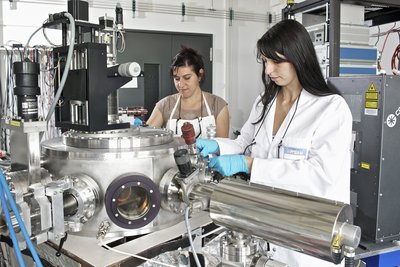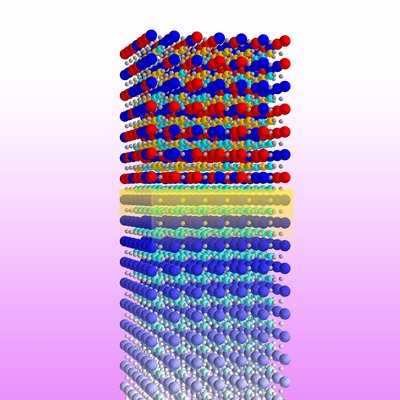When two insulators become conductors
How can two materials which do not conduct electricity create an electrically conducting layer when they are joined together?
Since this effect was discovered in 2004, researchers have developed various hypotheses to answer this question - each with its own advocates, who defend it and try to prove its validity.
Now, an international team under the leadership of researchers at the Paul Scherrer Institute has probably settled the controversy. They have shown that it is the combination of the properties of both materials that produces the effect and therefore disproved an alternative hypothesis, which proposes that the materials mix at the interface to create a new, conducting material.
The materials under study are so-called perovskites, members of a large class of materials with interesting electrical or magnetic properties that could play a significant role in electronics and computing in the future.


In 2004, researchers discovered that if two materials, SrTiO3 and LaAIO3 - both of which are electrical insulators - are joined together, a thin, electrically conducting region is formed at their interface.
Since then a number of hypotheses were proposed to explain this effect, which has led to controversy ever since.
Of the various explanations, effectively only two competing hypotheses have survived.
To compare their relative merits, an appropriate experiment was performed by scientists at PSI, together with colleagues from the University of Geneva. In addition, scientists from the University of Liège have contributed important theoretical insights.
Both substances are complex metal-oxide materials - so-called perovskites - with a typical layered structure. In SrTiO3, the structure consists of alternating planes of strontium oxide (SrO) and titanium dioxide (TiO2), while in LaAIO3, they are lanthanum oxide (LaO) and aluminium dioxide (AIO2).
The two materials, however, differ in one crucial aspect.
In SrTiO3, both planes are electrically neutral, while in LaAIO3 they are alternately positively and negatively charged. The combination of two such materials leads, in the opinion of one school of thought, to the transfer of mobile electrons to the interface between the two materials, making this ultrathin interfacial region conducting. This happens, however, only when the LaAIO3 film is thick enough. Otherwise, the combination of materials remains an insulator.
This hypothesis is known as the ‘polar catastrophe’. Other researchers are nevertheless convinced that conductivity is created because both compounds are known to combine at their interface and this intermixed material is conducting.
To clarify this controversy, the researchers wanted to answer the question, “Is a mixture of the two substances conducting?” Researcher at PSI Mathilde Reinle-Schmitt says, “We used again SrTiO3 and LaAIO3 in various proportions and thicknesses and then measured the conductivity.
The results were surprising. For thin layers of deposited mixtures, the system was insulating, while for thicker layers the interface was conducting, although the layers themselves were not, just as for pure LaAIO3.
What changed was that the mixed layer had to be correspondingly thicker with less LaAIO3 in the mixture.
Perovskites, the category to which the materials being investigated belong, often have interesting electrical and magnetic properties, some of which have never been observed in any other materials.
An additional important property is highlighted by Philip Willmott, leader of the investigating group at PSI.
In contrast to traditional semiconductors used today, different perovskites have a similar crystalline and chemical structure and can be incorporated so that materials with different characteristics can be combined into a single device, such as a superconductor with a material which reacts sensitively to magnet fields or one that can detect substances in the air.
Materials in which the current does not flow in all three dimensions but in only one or, as here, in two, are also current topics of research that could lead to numerous applications.
www.psi.ch
A surprise contender for cooling computers: lasers
Laser cooling company Maxwell Labs has partnered with Sandia National Laboratories to develop...
Manufacturable chipset developed for quantum computing
Twenty years since the first photonic qubit breakthroughs, PsiQuantum has unveiled...
Wearable biosensors enable real-time health monitoring
Researchers have developed wearable sensors that can track health biomarkers non-invasively using...





